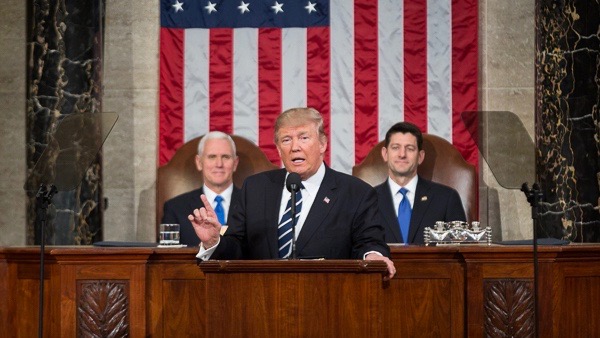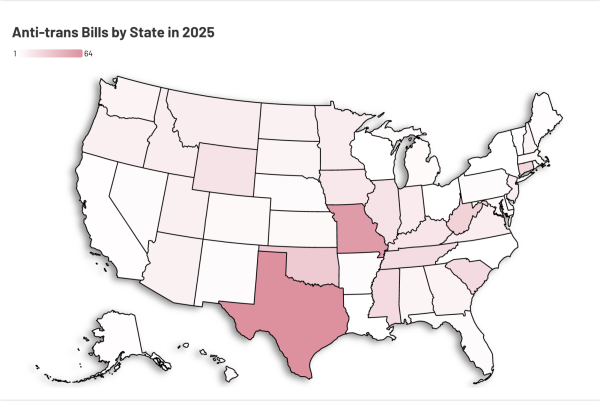As first 100 days end, Americans review Trump’s actions

Trump’s first 100 days are drawing to a close. As such, many are looking back at the achievements and failures of his young administration.
The first 100 days of a presidential administration have long been a crucial date in American politics. The 100-day period, which can function as a benchmark for presidents to be compared in their effectiveness, is seen as the point at which the president is most powerful and most able to enact his agenda. President Franklin D. Roosevelt created the idea of a 100 days full of sudden progress by, in just three months, establishing a number of essential New Deal programs to aid the poor and put the unemployed to work, preventing total economic collapse, and reviving public confidence. Since Roosevelt, presidents have promised to bring sweeping reform in their first 100 days: President Ronald Reagan proposed deep tax cuts and President Barack Obama proposed an ambitious stimulus package to halt the global financial crisis of 2008-2009.
On the campaign trail, President Donald Trump promised ambitious—and, his critics said, unrealistic—changes: repealing and replacing the Affordable Care Act (ACA), beginning the construction of a wall on the Southern border, cracking down on illegal immigration, repealing Obama-era regulations, and appointing a conservative Supreme Court justice to replace the late Justice Antonin Scalia. Below is a list of what Trump did in his first 100 days.
January 20: Trump is inaugurated as the 45th president of the United States.
January 23: Trump withdraws the United States from the Trans-Pacific Partnership, prevents foreign aid from going to charities which perform abortions, and initiates a 90-day hiring freeze on the federal workforce.
January 24: Trump approves construction of the Keystone and Dakota Access pipelines.
January 25: Trump signs Executive Order 13767, which orders the Department of Homeland Security to begin constructing a wall on the Southern border. Trump also signs Executive Order 13768, which bans “sanctuary cities” that protect undocumented immigrants from receiving federal grants, creates the Declined Detainer Outcome Report to compile and release a list of crimes committed by undocumented immigrants, and significantly increases the number of undocumented immigrants eligible for deportation.
January 27: Trump signs Executive Order 13769, which bans refugees from seven Muslim-majority countries from entering the U.S. for 90 days, suspends the refugee resettlement program for 120 days, and lowers the number of refugees being admitted to the U.S. in 2017 to 50,000. The order causes chaos in U.S. airports and mass protest across the U.S.
January 31: Trump nominates Tenth Circuit Court of Appeals Judge Neil Gorsuch to the Supreme Court to replace the late Justice Antonin Scalia.
February 3: Executive Order 13769 is suspended by U.S. District Court Judge James Robart.
February 13: Following a scandal over his ties to Russia, National Security Adviser Michael Flynn resigns.
February 16: Trump signs a repeal of the Stream Protection Rule, which was intended to protect streams from coal-related pollution and had received criticism from conservatives.
February 20: Under Trump’s Executive Order 13768, the Department of Justice creates an Office of Victims of Immigration Crime Engagement to provide services to victims of crimes by undocumented immigrants.
March 2: Attorney General Jeff Sessions says he will not involve himself in the inquiry into Trump associates’ ties with Russia after the revelation that he had met with Russian ambassador Sergey Kislyak.
March 4: Trump claims that Obama wiretapped him in a tweet.
March 6: Trump signs Executive Order 13780, which places limits on travel to the U.S. from certain countries. Republicans release their plan to repeal and replace the ACA.
March 20: The American Health Care Act (AHCA), which is intended to repeal and replace the ACA, is introduced by House Republicans. The policy is maligned by all corners of the political world and is dubbed “Trumpcare.” Federal Bureau of Investigation Director James Comey denies that any wiretaps on Trump were conducted.
March 24: The AHCA is withdrawn after receiving insufficient support from both hard-line conservatives and Republican moderates; Ryan says that the U.S. is “going to be living with Obamacare for the foreseeable future.” Trump signals that he will move on to other issues.
March 29: U.S. District Court Judge Derrick Watson indefinitely suspends Executive Order 13780.
April 6: Trump orders a missile strike on the Shayrat Air Base in Syria in retaliation for chemical attacks by Syria’s government against its citizens.
April 7: After a Democratic filibuster of the confirmation of Gorsuch and a Republican effort to change the rules to allow filibusters on Supreme Court justices to be ended with a majority of votes (rather than the 60 senators previously required), a move called “the nuclear option,” Gorsuch is confirmed by the Senate.
April 10: Gorsuch takes office as a Supreme Court justice.
April 13: A Massive Ordinance Air Blast (MOAB) bomb, the largest non-nuclear bomb ever dropped by the U.S. military, is dropped on an Islamic State camp in Afghanistan, near the Pakistani border.







